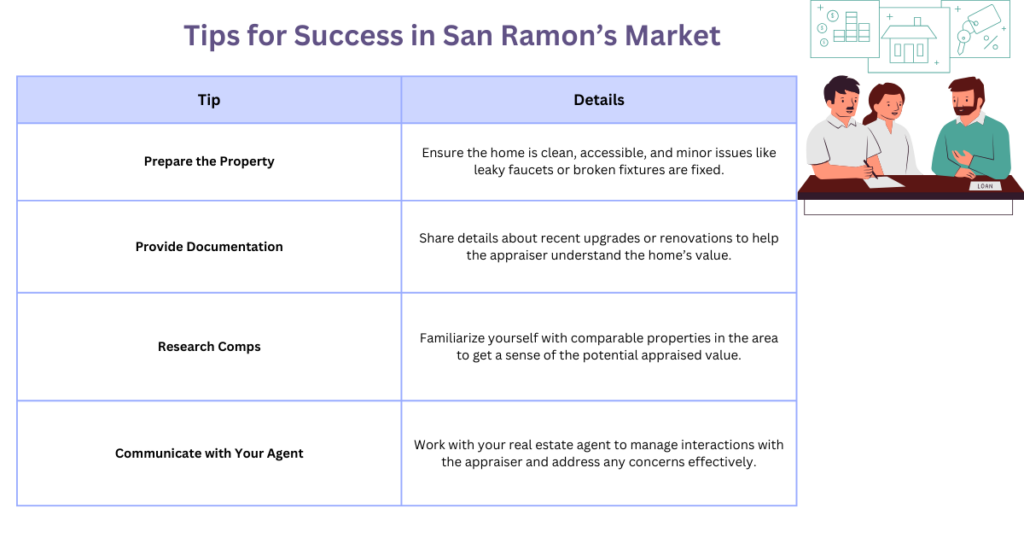Table of Contents
ToggleIntroduction
Securing a lucrative real estate deal in a highly competitive market like California is a dream. Home loan appraisal is one crucial step in your home-buying journey, helping your lender evaluate the property’s fair market value.
Since the property’s value is likely to be affected by many factors, loan appraisal helps align the loan amount with the property’s worth, ensuring financial security for both parties.
In this blog, we will understand how a loan appraisal truly works, highlighting its importance, and how you can navigate this phase easily and confidently.
Loan Appraisals: What You Need to Know?
- A home loan appraisal involves an unbiased estimation of the property’s actual worth to ensure that the lenders and borrowers both are protected from overlending or overpaying during the loan process.
- These appraisals are supervised by a licensed appraiser based on certain factors of the property’s size, location, and comparable property sales rather than the owner’s or buyer’s sentimental or emotional value attached to it.
The Appraisal’s Journey: Here’s What To Expect
Securing a house loan, refinancing an existing mortgage, or determining the actual value of a property all depend on the appraisal process. Let’s understand what all you can expect in your appraisal journey in detail:
Appraisal Request
- The first step in your appraisal journey is when the lender initiates an appraisal request, which usually comes after you have already applied for your home loan.
- This request is conducted by a licensed appraiser to make sure that it is an honest and unbiased evaluation
- The cost of the appraisal can be upfront, at closing, or borne by the lender by loan terms and conditions.
Scheduling the Request
- The second step involves the appraiser deciding a time and date to visit and thoroughly evaluating the property’s value.
- For buyers, the appraiser communicates with the lender or their agent to access the property. In case you’re refinancing, the appraiser will directly communicate to set up an appointment.
Property Inspection
- The third step in your appraisal journey is the inspection of the property’s physical condition and features, which includes the following:
Inspection Activity | Details |
Measuring Square Footage | The appraiser calculates the home’s total livable space to ensure accurate valuation. |
Assessing Key Elements | Evaluates the condition of critical components like the foundation, roof, windows, and HVAC. |
Noting Upgrades and Features | Highlights enhancements such as remodeled kitchens, modern finishes, or a landscaped backyard. |
Identifying Damage or Maintenance | Documents visible issues, including damage or deferred maintenance that could lower the value. |
- The location of the property, neighborhood amenities, and any potential environmental issues are also taken into account by the appraiser during the inspection, which usually takes 30 minutes or a few hours depending entirely on the size and other complexities of the property involved.
Comparative Market Analysis
- The next step in this process is carrying out a detailed Comparative Market Analysis. This is done to create a clear comparison between the recently sold properties in the area with similar details and features, which are known as ‘comps’.
- The ultimate reason is to identify how your property stands in terms of valuation. Let us have a look at the main aspects to consider while conducting CMA:
CMA Component | Details |
Identifying Comparable Sales | The appraiser selects 3–5 recently sold homes within the same neighborhood or area. |
Evaluating Similar Features | Comps are chosen based on similarities in size, age, condition, and amenities to the appraised home. |
Adjusting for Differences | The appraiser adjusts values to account for differences, like one home having an extra bedroom. |
Analyzing Market Trends | Includes reviewing local market conditions, such as rising or falling home prices. |
The Appraisal Report
- The final step in your home loan appraisal is the preparation of an official appraisal report by the appraiser. This report includes all the findings and necessary elements, which include:
- Supporting photos and data
- Final appraised value
- Market analysis
- Comparable sales (Comps)
- Property details
- This document is a deciding factor in your loan approval or rejection while promoting transparency for all parties involved.


How to Handle Common Appraisal Curveballs
Appraisals can also encounter obstacles, which can cause delays and disruptions in your loan process. Let us understand how to tackle these common obstacles to ensure that your home loan journey is completed without any unnecessary stress or anxiety:
Delays
- A high surge in the demand for appraisers, scheduling mishaps, and unclear disclosure of property information may cause unwanted delays in your appraisal process.
- Flexibility, staying proactive, and asking for continuous updates ensure that the process is carried out smoothly and efficiently.
Condition-Related Problems
- The physical conditions of the property involved also result in unnecessary difficulties in the home loan appraisal. These include faulty electrical systems, cracked rooftops, or foundation cracks, which can ultimately result in lower appraisal value or repairs before the loan is approved.
- Resolving the issues or negotiating the repairs eliminates any room for delays or lesser loan amount approval.
Low Appraisal Value
- A major curveball in the entire home loan appraisal process is a lower appraisal value proposed by a professional appraiser, which ultimately affects the loan amount and your confidence to continue with the purchase.
- This value can be improved and worked upon by following the below-mentioned ways to keep the process moving forward:
|
Issue |
How to Handle It |
|
Renegotiate the Price |
If the appraisal is lower than expected, ask the seller to reduce the price to match the appraised value. |
|
Appeal the Appraisal |
Provide additional data or comparable sales to challenge the appraisal and ask for a re-evaluation. |
|
Increase Your Down Payment |
If the seller won’t lower the price, consider increasing your down payment to cover the difference. |
|
Walk Away |
If the low appraisal significantly impacts your finances, walking away from the deal might be the best option. |
Conclusion
A home loan appraisal is a pivotal step in your home loan journey as it ensures what you are paying for is worth the investment. California’s real estate market is highly competitive, and with fluctuating real estate prices, successful loan appraisals equip buyers, sellers, and lenders with the confidence to pursue their decisions.
At Munshi Capital, we understand the importance of a strong loan appraisal and how it brings you one step closer to your dream abode. Partnering with Munshi Capital will help you acquire the guidance and expertise to navigate the challenges of low appraisal value as well as working with appraisers with ease and confidence. With our support in this fast-paced real estate market, we will make sure that you stay ahead in your home loan journey seamlessly.
Read more: Asking Questions during Home Showing: A Must-do Guide
Frequently Asked Questions
1. What is the duration of a home loan appraisal in California?
These appraisals are usually over in 7-10 days but it may vary depending on the market demand and appraiser availability.
2. What is the overall cost incurred in a home loan appraisal in California?
Single-family homes attract appraisal costs ranging between $600-$700 but may reach up to $1000 for more complex properties.
3. What is the role of appraisals in refinancing?
Appraisals help in determining the current value of the property to ensure that it aligns with your loan amount and can also create the opportunity to eliminate private mortgage insurance altogether if the property encounters a steep rise in its prices.




